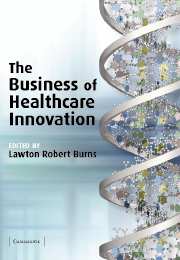1 - The business of healthcare innovation in the Wharton School curriculum
Published online by Cambridge University Press: 22 September 2009
Summary
Innovation and the value chain in healthcare
All first-year MBA students at the Wharton School who major in healthcare systems take a required course during their first semester. The course, Healthcare Management 841, analyzes the entire value chain in healthcare (see figure 1.1). The structure of this chain is straightforward: there are three key sets of actors and two sets of intermediaries between them. The three key sets of actors are the individuals and institutions that purchase healthcare, provide healthcare services, and produce healthcare products (purchasers, providers, and producers). Two sets of intermediaries separate these key actors: those firms who finance healthcare (offer insurance to the purchasers and handle reimbursement to the providers) and those who distribute products (from the producers to the providers).
The logic of this chain is a bit more interesting. All of the money that gets pumped into the healthcare system starts on the far left side of figure 1.1 and flows to all of the boxes to the right. Conversely, much of the innovation in healthcare starts on the far right side and flows to the adjacent boxes on the left. The two flows collide in the middle, in the provider side of the industry, that is, doctors and hospitals who then have to determine how much of the innovation from the right side they can afford to utilize in patient treatment given the limited supply of funds received from the left side.
- Type
- Chapter
- Information
- The Business of Healthcare Innovation , pp. 1 - 24Publisher: Cambridge University PressPrint publication year: 2005
- 2
- Cited by



